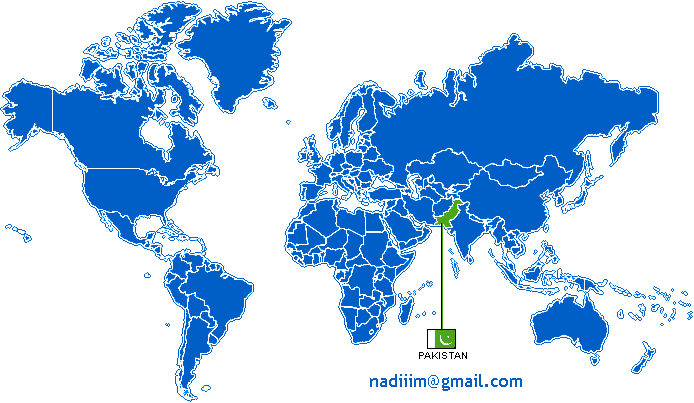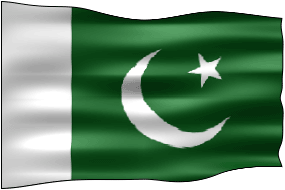
|
||||||||||||||||||||||||||||||
|
|
|
|||||||||||||||||||||||||||||
|
Pakistan
Introduction of Pakistan
H istory of Pakistan:-Pakistan emerged on the map of the world as an Islamic Republic on 14 August,1947,as an outcome of the struggle by the Muslims of the Indian subcontinent for an independent Muslim state. The leadership of the Quaid-e-Azam Muhammad Ali Jinnah(1876-1948),turend into reality, the dream of the poet philosopher Allama Sir Dr. Muhammad Iqbal(1877-1938) to have a separate homeland for the Muslims of South Asia. . Pakistan celebrated its independence Golden Jubilee in 1997.Pakistan traces its history back
to 2,500 years B.C., when a highly developed civilization flourished in the
Indus Valley. Excavations at Harrappa, Moenjodaro, Kot Diji and Mehr Garh have
brought to light, the evidence of an advanced civilization existing even in more
ancient times. Around 1,500 B.C., the Aryans overwhelmed this region and
influenced the Hindu civilization, whose centre moved to Ganges valley, further
east. Later, the Persians occupied the northern region in the 5th century B.C.
up to the 2nd century AD. The Greeks came in 327 B.C., under Alexander of
Macedonia, and passed away like a meteor. In 712 AD, the Arabs, led by Muhammad
Bin Qasim, landed somewhere near modern Karachi and ruled the lower half of
Pakistan for 200 years. During this time, Islam took roots in the soil and
influenced the life, culture and traditions of the people. Independence Movement :-The Muslim revival began towards the end of the last century when Sir Syed Ahmed Khan, a renowned Muslim leader and educationist, launched a movement for intellectual renaissance of the Muslims of South Asia. In 1930, the well-known poet-philosopher, Allama Muhammad Iqbal, conceived the idea of a separate state for the Muslims of South Asia. In 1940, a resolution was adopted by the All-India Muslim League, demanding a separate independent home land for the Muslims. After 07 years of un-tiring struggle under the brilliant leadership of Quaid-e-Azam (the great leader) Muhammad Ali Jinnah, Pakistan emerged on the world map as a sovereign state, on 14th August,1947. Geography :-Pakistan is situated between latitude 24 and 37 degrees North and longitude 62 and 75 degrees East. The country borders Iran on the west, India in the east, Afghanistan in the north-west, China in the north and the Arabian Sea on the south. The great mountain ranges of the Himalayas, the Karakorams and the Hindukush form Pakistan's northern highlands of North West Frontier Province and the Northern Area. Punjab province is a flat, alluvial plain with five major rivers dominating the upper region eventually joining the Indus River flowing south to the Arabian Sea. Sindh is bounded on the east by the Thar Desert and the Rann of Kutch and on the west by the Kirthar range and the Balochistan Plateau is an arid tableland, encircled by dry mountains. Pakistan displays some of Asia’s most magnificent landscapes as it stretches from the Arabian Sea, its southern border, to some of the world’s most spectacular mountain ranges in the north. Pakistan is also home to sites that date back to word’s earliest settlements rivaling those of ancient Egypt and Mesopotamia. Location:- Located in South Asia, Pakistan shares an eastern border with India and a north-eastern border with China. Iran makes up the country’s south-west border, and Afghanistan runes along its western and northern edge. The Arabian Sea is Pakistan’s southern boundary with 1,064 km of coastline. The country has a total area of 796,095 sq km and is nearly four times the size of the United Kingdom. From Gwadar Bay in it’s south-eastern corner, the country extends more than 1,800 km to the Khunjerab Pass on China’s border. Basic Facts :-
Official Name: Islamic Republic of Pakistan Father of the Nation: Quaid-i-Azam Muhammad Ali Jinnah (1876-1948) National Poet: Allama Muhammad Iqbal (1877-1938) Head of the State: General Pervez Musharraf, President Head of Government: Shaukat Aziz , Prime Minister Capital: Islamabad Area:-
Population 153.96 million (E) Administrative Setup Pakistan is divided into four provinces viz., North West Frontier Province (NWFP), Punjab, Sindh and Balochistan. The tribal belt adjoining NWFP is managed by the Federal Government and is named FATA i.e., Federally Administered Tribal Areas. Azad Kashmir and Northern Areas have their own respective political and administrative machinery, yet certain of their subjects are taken care of by the Federal Government through the Ministry of Kashmir Affairs and Northern Areas. Provinces of Pakistan are further divided into Divisions and Districts
While FATA consist of 13 Areas/Agencies and Azad Kashmir and Northern Areas have 7 and 5 Districts respectively. Religion 95% Muslims, 5% others. Annual Per capita income US $736 GDP 8.4% Currency Pak. Rupee. Imports Industrial equipment, chemicals, vehicles, steel, iron ore, petroleum, edible oil, pulses, tea. Exports Cotton, textile goods, rice, leather items carpets, sports goods, handi-crafts, fish and fish prep. and fruit Languages Urdu (National) and English (Official) Literacy rate 53% Government Parliamentary form Parliament Parliament consists of two Houses i.e., the Senate (Upper House) and the National Assembly (Lower House). Main Regional Languages: Sindhi Balochi Punjabi Pashto Currency :Basic unit of currency is Rupee which divides into 100 Paisa. Currency notes of 5000, 1000, 500, 100, 50, 10, 5, 2, and 1 rupees are in use. Coins of 01 & 02 Rupees are in circulation. The Senate is a permanent legislative body and symbolizes a process of continuity in the national affairs. It consists of 100 members. The four Provincial Assemblies, Federally Administered Tribal Areas and Federal Capital form its electoral college. The National Assembly has a total membership of 342 elected through adult suffrage (272 general seats, 60 women seats and 10 non-Muslim seats). |
||||||||||||||||||||||||||||||





